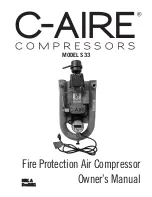
10
XAHS 146 Dd - XATS 156 Dd - XA(S) 186 Dd - XAVS 166 Dd - XAHS 186 Dd
18 When repair has been completed, the machine shall be barred over at
least one revolution for reciprocating machines, several revolutions for
rotary ones to ensure that there is no mechanical interference within the
machine or driver. Check the direction of rotation of electric motors
when starting up the machine initially and after any alteration to the
electrical connection(s) or switch gear, to check that the oil pump and
the fan function properly.
19 Maintenance and repair work should be recorded in an operator’s
logbook for all machinery. Frequency and nature of repairs can reveal
unsafe conditions.
20 When hot parts have to be handled, e.g. shrink fitting, special heat-
resistant gloves shall be used and, if required, other body protection
shall be applied.
21 When using cartridge type breathing filter equipment, ascertain that the
correct type of cartridge is used and that its useful service life is not
surpassed.
22 Make sure that oil, solvents and other substances likely to pollute the
environment are properly disposed of.
23 Before clearing the unit for use after maintenance or overhaul, check
that operating pressures, temperatures and speeds are correct and that
the control and shutdown devices function correctly.
1.6
T
OOL
APPLICATIONS
SAFETY
Apply the proper tool for each job. With the knowledge of correct tool use
and knowing the limitations of tools, along with some common sense, many
accidents can be prevented.
Special service tools are available for specific jobs and should be used when
recommended. The use of these tools will save time and prevent damage to
parts.
1.7
S
PECIFIC
SAFETY
PRECAUTIONS
Batteries
When servicing batteries, always wear protecting clothing and glasses.
1
The electrolyte in batteries is a sulphuric acid solution which is fatal if it
hits your eyes, and which can cause burns if it contacts your skin.
Therefore, be careful when handling batteries, e.g. when checking the
charge condition.
2
Install a sign prohibiting fire, open flame and smoking at the post where
batteries are being charged.
3
When batteries are being charged, an explosive gas mixture forms in the
cells and might escape through the vent holes in the plugs.
Thus an explosive atmosphere may form around the battery if
ventilation is poor, and can remain in and around the battery for several
hours after it has been charged. Therefore:
- never smoke near batteries being, or having recently been, charged,
- never break live circuits at battery terminals, because a spark usually
occurs.
4
When connecting an auxiliary battery (AB) in parallel to the unit battery
(CB) with booster cables: connect the + pole of AB to the + pole of CB,
then connect the - pole of CB to the mass of the unit. Disconnect in the
reverse order.
Pressure vessels
(according to directive 87/404/EEC annex II § 2)
Maintenance/installation requirements:
1
The vessel can be used as pressure vessel or as separator and is designed
to hold compressed air for the following application:
- pressure vessel for compressor,
- medium AIR/OIL,
and operates as detailed on the data plate of the vessel:
- the maximum working pressure ps in bar (psi),
- the maximum working temperature Tmax in °C (°F),
- the minimum working temperature Tmin in °C (°F),
- the capacity of the vessel V in l (US gal, Imp gal, cu.ft).
2
The pressure vessel is only to be used for the applications as specified
above and in accordance with the technical specifications. Safety
reasons prohibit any other applications.
3
National legislation requirements with respect to re-inspection must be
complied with.
4
No welding or heat treatment of any kind is permitted to those vessel
walls which are exposed to pressure.
5
The vessel is provided and may only be used with the required safety
equipment such as manometer, overpressure control devices, safety
valve, etc.
6
Draining of condensate shall be performed regularly when vessel is in
use.
7
Installation, design and connections should not be changed.
8
Bolts of cover and flanges may not be used for extra fixation.
Safety valves
All adjustments or repairs are to be done by an authorized representative of
the valve supplier
(see maintenance schedule 4.2)
.
Содержание XA(S) 186 Dd
Страница 2: ......
Страница 43: ......
Страница 44: ...Printed in Belgium 11 2006 2954 2230 02 www atlascopco com ...











































